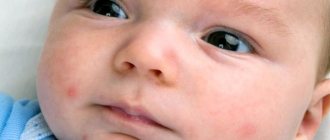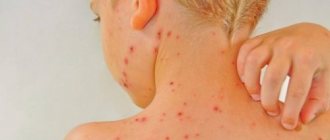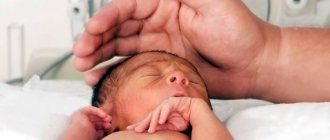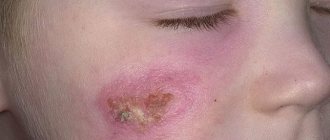The human heart consists of several segments, each of which is capable of generating impulses of different frequencies. Only the sinus section is the one that is capable of contracting 60 times per minute, thereby ensuring stable functioning of the myocardium. Severe sinus arrhythmia in a child refers to various heart rhythm disturbances. These may appear in the form of:
- sinus tachycardia (rapid heartbeat);
- sinus bradycardia (slow heart rate);
- extrasystoles (untimely contractions of the myocardial chambers).
Normal age-related heart rate indicators are individual for each person. However, there are average values that doctors use to diagnose heart disease (child’s age – number of beats/minute):
| CHILD'S AGE | Heart rate (beats/minute) |
| newborns – up to 1 month | 110-170 |
| children under 1 year | 102-162 |
| up to 2 years | 94-154 |
| 2-4 years | 90-140 |
| 4-6 years | 96-126 |
| 6-8 years | 78-118 |
| 8-10 years | 68-118 |
| 10-12 years | 60-100 |
| 13-15 years old | 60-90 |
What it is
Heart contractions occur due to sinus rhythm. A collection of nerve fibers in the right atrium is capable of generating electrical impulses, which are then transmitted to the ventricle and stimulate contraction. The number of impulses that originate in the heart depends on the age of the patient. The entire conduction system works like a large motor, which is necessary to obtain energy and provide blood circulation.
Normally, sinus rhythm should occur at regular intervals, and in case of disturbances, cardiologists diagnose the condition of arrhythmia.
The number of heartbeats (beats/minute) for children of different ages is:
- First month of life – up to 150
- Up to a year – 120-130
- 1-3 years – 110-120
- 3-8 years – 100
- 8-12 – 80-90
- Over 12 – 60-80
With arrhythmia, the number of heart beats can remain within normal limits, but their rhythm becomes confused and the intervals become unequal.
Depending on whether the electrical impulse is formed with a delay or advance, several types of arrhythmias are distinguished:
- the number of strokes remains within the normal range
- the number of contractions increases - tachycardia
- the number of rhythms decreases – bradycardia
Risk factors
Sinus arrhythmia can be of congenital origin, hereditary or acquired.
Acquired disorders occur in people with risk factors, which include:
- alcohol abuse
- addiction
- endocrine disruption, especially in the thyroid and adrenal glands
- unhealthy diet, including unbalanced vegetarianism, which leads to the development of anemia
- infectious diseases that are accompanied by electrolyte deficiency and hypovolemia
- problems during childbearing, including premature birth and fetal hypoxia, can provoke congenital innervation disorders, which after birth will manifest as arrhythmia
Choose a specialist, read reviews and make an appointment with a cardiologist online
Forecast
Non-dangerous forms of arrhythmia go away virtually without the participation of a doctor and do not provoke the development of complications. Organic types of failure often lead to heart failure, asystole, atrial fibrillation and other dangerous consequences. Because of them, the child may become disabled or die. The prognosis will depend on the severity of the underlying pathological process and the effectiveness of the course of therapy. In advanced cases, surgical intervention is used.
The sinus form of arrhythmia occurs in every second baby. It rarely leads to complications and is virtually invisible. In most cases, such a failure is detected using an ECG. If it was caused by pathologies of the heart or other organs, then the course of therapy will be aimed at eliminating them. The treatment regimen will include medications, physiotherapeutic procedures and lifestyle adjustments. If there is no result, surgical intervention will be used. Milder cases of arrhythmia can be eliminated by reducing physical activity, avoiding stress and proper diet.
Forms
Depending on the mechanism of occurrence of the pathology, several forms of arrhythmia are distinguished. Below we discuss which of them are safe and which can lead to serious complications.
Respiratory
In most cases, this form is considered harmless. It is respiratory arrhythmia that is often diagnosed in children, and its cause lies in the immaturity of the nervous system. As the child grows up, the disorder will disappear, and the work of the heart will be restored. While symptoms are still present, the child should be registered with a cardiologist in order to undergo periodic examinations and promptly identify sudden complications.
Respiratory arrhythmia is manifested by an increase in heart rate during inhalation and a slower rate during exhalation. In children, such a disorder is not considered a diagnosis and does not limit the child from attending any type of event, including sports activities.
In addition to delayed maturation of the nervous system, respiratory arrhythmia can be provoked by pathological causes:
- increase in ICP
- neurological diseases and brain damage due to hypoxia
- defective development of the body due to premature birth
- metabolic disorders that affect breathing and heart function
Functional
Here the rhythm of contractions is disrupted due to functional disorders of the organ. Very often they are temporary and occur as a concomitant symptom of other problems in the body (decreased immunity, hormonal imbalances). It may occur after an infectious disease or as a result of malfunction of the endocrine organs. This form is uncommon and is usually regarded as a harmless condition. Once the cause is eliminated, heart function returns to normal.
Organic
This form is the most dangerous and is diagnosed in the presence of serious pathologies in the structure of the heart. Anatomical disorders affect both the tissues of the organ itself and the nerve conduction system. Symptoms of organic disorders are most pronounced, and the consequences can be quite serious, so the disease requires urgent treatment over a long period of time.
Rhythm disturbances due to organic changes are permanent and do not go away without treatment. Arrhythmia negatively affects the child’s condition and worsens his quality of life. The patient requires a complete diagnosis with an accurate determination of the cause of the pathology and the selection of a comprehensive treatment regimen. This form of arrhythmia rarely appears in isolation; more often it is accompanied by other diseases - rheumatism, heart defects, myocarditis.
What diseases negatively affect the sinus node?
There is such a concept in medicine as sick sinus syndrome, or SSS. With such a violation, this structure malfunctions, which leads to severe disorders. A sinusoidal heart rhythm is considered normal in the results of ECG interpretation. When changes have occurred in this zone, the rate of beating of the organ will no longer be the same.
The sinus node is located between the right atrium and the vena cava, and serves as a rhythm regulator. In this part of the organ there are nerve fibers through which signals are transmitted to increase heart contractions or decrease them, if such a need arises. The natural process of increasing the rate of beating of an organ can cause emotional and physical stress, as well as other non-pathological factors.
By maintaining a constantly normal heart rate, the sinus node ensures proper contraction of all chambers of the organ, fully overcoming vascular resistance, as well as good blood circulation. This function operates under the influence of a cluster of cells of the rhythmogenic type; they can produce a nerve signal, and then help it move further along the area of the conduction system.
Normal automaticity and sufficient conductivity of impulses can guarantee good filling of the arteries of the brain and heart with blood, preventing the development of ischemia. Weakness of the sinus node causes this entire process to fail, and the rhythm of the organ changes.
Reasons for violations:
- Heart diseases, which include hypertrophy, arterial hypertension, ischemic lesions of any severity, inflammatory processes in the organ, myocardiopathy, injuries and defects of an acquired and congenital nature, operations.
- Systemic diseases characterized by degenerative disorders in tissues when muscle tissue is replaced with scar tissue. Such ailments include SLE or systemic lupus erythematosus, amyloidosis, scleroderma, and inflammation of idiopathic origin.
- Pathologies of the endocrine system - an increase or decrease in the synthesis of hormones. Thyrotoxicosis or hyperthyroidism is most often the cause of sinus node weakness.
- Neoplasms in the heart and nearby areas with a malignant course.
- An inflammatory process of a specific nature that accompanies the tertiary period of human infection with syphilis.
In addition, there are secondary causes of disorders in the sinus node. Such conditions are not directly related to heart pathologies; they are inorganic in relation to this organ.
Secondary factors:
- Hypercalcemia.
- Side effects of certain medications (Clonidine, Dopegit, beta-blockers, cardiac glycosides and others).
- Hyperkalemia.
- Some diseases of the genitourinary system, digestive tract, hypothermia or high pressure inside the skull, which is accompanied by hyperactivity of the vagus nerve.
Signs of illness
The clinical picture of the disease may vary. To suspect that you have such a disease, you need to know its main signs. The paroxysmal course of the pathology is characterized by an abrupt onset of manifestation; an attack can occur at any moment and last from a few seconds to many hours, and then end suddenly. The chronic type of the disease has a different character. The heart beats faster all the time.
The condition of such a patient may periodically worsen or improve.
Signs:
- difficulty breathing, shortness of breath;
- general weakness of the body that occurs suddenly;
- a strong heartbeat that a person feels, the fluttering of an organ in the chest;
- swelling of the lung tissue;
- attacks of suffocation;
- dizziness;
- arrhythmic type shock;
- trembling of the limbs or the whole body;
- false urge to urinate.
If adequate treatment is not available, the disease can cause complications in the form of other dangerous ailments, even when the rate of tachyarrhythmia is moderate. Often such consequences are: stagnant blood processes, cardiac asthma, severe swelling of the lung tissue, coma, organ failure and death.
Symptoms
Symptoms of arrhythmia are usually nonspecific and are often discovered incidentally during treatment for another disease. In infants, instability of heart contractions can be manifested by paroxysmal shortness of breath, changes in skin color towards pallor or cyanosis, restless behavior, poor sleep, poor weight gain, refusal to eat, and pulsation of the blood vessels in the neck.
At an older age, arrhythmia in a child can cause the following symptoms:
- increased fatigue
- discomfort in the heart area
- low blood pressure
- fainting and dizziness
- weakness during exercise
The causes of this discomfort are impaired blood circulation, due to which the tissues of the skin and internal organs are poorly supplied with oxygen, experience hypoxia and function worse. Arrhythmias, in which there is a prolongation of the QT interval or ventricular tachycardia, are considered dangerous to health and can lead to sudden death of the baby.
Diagnosis of arrhythmia must be carried out very carefully, determining the type of disorder, its cause and severity, since treatment tactics and prognosis depend on this. Dangerous arrhythmias are also considered to be those that are accompanied by cerebral hypoxia, myocardial ischemia, and heart failure.
According to the degree of severity, moderate and severe arrhythmia are distinguished. With moderate arrhythmia, the symptoms are nonspecific and mild. In most cases, this type of disorder goes away as the child gets older and is not detected in adults. Treatment is usually not required, and the doctor can only prescribe mild sedatives and lifestyle changes.
Only a specialist can determine the severity of disturbances in heart rhythm after conducting instrumental studies. It is absolutely forbidden to diagnose yourself based on your own health or the advice of friends.
With severe arrhythmia, the problem continues into adulthood, although it is detected quite early. The symptoms of such a sinus disorder are usually pronounced. The pathology is often diagnosed during examination during complaints of heart pain, fainting or other cardiovascular diseases. It is very important for the patient not to refuse a full comprehensive examination if it was prescribed by the doctor. Often the cause of pathology is found completely different from where it was supposed to be looked for at the beginning.
Young children often cannot correctly articulate what is bothering them.
In this case, parents should closely monitor the child’s well-being and be wary if the following symptoms appear:
- repeated loss of consciousness or dizziness
- increased sweating
- blueness of the nasolabial triangle or general pallor of the skin
- irritability, restlessness, lethargy
- shortness of breath during physical activity, even with light exertion
- restless and shallow sleep
- cardiopalmus
There are also clinically insignificant arrhythmias (which do not affect the child’s quality of life) and clinically significant ones (for which persistent cardiac dysfunction is diagnosed).
Symptoms and diagnosis
Irregular sinus rhythm, which is of a respiratory nature, usually does not “announce” itself in any way. The pulse returns to normal after the influence of the conditioning factor ceases.
If SA is not dependent on breathing, parents should pay attention to the following alarming “signals” from the baby’s body:
- shortness of breath, difficulty breathing;
- chest pain;
- fast fatiguability;
- frequent dizziness;
- general weakness, swelling;
- fainting conditions;
- causeless apathy, or, conversely, unsubstantiated anxiety;
- body weight deficiency;
- insomnia or intermittent restless night sleep;
- hyperhidrosis (periodic attacks of increased sweating even with minimal physical exertion);
- the nasolabial triangle turns blue.
These manifestations are a reason for an immediate visit to a cardiologist.
Diagnosis of SA involves:
- Listening to the heart using a phonendoscope, determining heart rate/minute and comparing the data obtained with normal age indicators.
- Carrying out electrocardiography (sinus arrhythmia in adolescents and children under 12 years of age “makes itself known” by lengthening during bradycardia or shortening the PP interval against the background of tachycardia).
Additional diagnostic measures:
- blood test (general, biochemical), urine;
- Ultrasound of the heart.
Severe or moderate sinus arrhythmia in a child is a reason to register him with a cardiologist.
Causes
Among the causes of arrhythmia, there are three types:
- Congenital. Appear when there are developmental disorders of the fetus during the intrauterine period. One of the main reasons is fetal hypoxia or a deficiency of beneficial nutrients in the mother’s body. This is exactly the condition that can be prevented and avoided if you take care of the pregnant woman’s health, ensure proper rest, lead a healthy lifestyle and take vitamin supplements.
- Hereditary. They are passed on genetically from parents who also have heart disease.
- Purchased. They are the most common group. Such disorders arise during a person’s life and are caused by strong emotional, psychological or physical stress. The cause may also be endocrine disorders, especially those that appear during puberty.
Among the more specific causes of sinus arrhythmia are the following:
- intracranial hypertension
- unbalanced growth of heart tissue and conduction system during periods of peak growth in children
- postpartum asphyxia
- rickets
- inflammatory diseases in the field of cardiology
- previous infection that caused electrolyte deficiency
- nutritional errors or metabolic disorders of microelements such as calcium, potassium, magnesium
Arrhythmias are also classified into cardinal, extracardiac and mixed etiologies. The first group includes congenital defects, as well as disorders of the tissue or nerve bundle of the heart that arose after birth. Mechanical damage to the organ structure, for example during angiography or probing, is also considered a cardiac cause.
Extracardiac factors that provoke sinus arrhythmia include:
- fetal prematurity
- endocrine disorders
- blood diseases
- problems during pregnancy
Mixed causes are observed with a combination of structural pathologies and disorders of the neurohumoral regulation of cardiac activity.
Features of the disease in newborns
Arrhythmias are most often diagnosed in premature newborns.
The violation can occur in several ways:
- bradycardia - heartbeats occur less than 100 times per minute. The causes are usually problems with intrauterine development. A mother may suspect a disorder based on the baby’s insufficient sucking, pale skin, and poor sleep.
- Tachycardia - the number of contractions exceeds 200 beats per minute.
Despite the fact that some types of arrhythmias may be physiological or harmless, the complete absence of such disorders in a child is considered the norm. In the maternity hospital, all newborns usually undergo an ultrasound and cardiogram, which allows existing pathologies to be identified in a timely manner.
It is also important to understand that the number and rhythm of a child’s heartbeat is influenced by his psycho-emotional state. Increased frequency can be caused by physical activity, crying, irritability during illness, and slowdown can be caused by sleep, calmness. The conduction system of the heart in children is imperfect, therefore, in the absence of organic disorders, the problem is likely to disappear in adulthood.
Sinus arrhythmia
Sinus arrhythmia This type of arrhythmia is characterized by the presence of unequal intervals between individual heartbeats. Typically, with sinus arrhythmia, there is a natural alternation of periods of increased or slow heart function. In most cases, the heart rate changes in connection with the phases of breathing: at the height of inspiration, the rhythm becomes faster, during exhalation it slows down. Therefore, sinus arrhythmia is sometimes called respiratory arrhythmia. Sinus arrhythmia is based on reflex fluctuations in the tone of the vagus nerve against the background of a general increase in its tone; in this case, sinus arrhythmia is often combined with bradycardia.
Sinus arrhythmia or otherwise respiratory arrhythmia Respiratory arrhythmia is often observed as a physiological phenomenon, especially at a young age. More severe degrees of sinus arrhythmia occur in children and especially adolescents (the so-called juvenile arrhythmia) due to the pronounced lability of the autonomic nervous system characteristic of this age. Severe sinus arrhythmia in combination with bradycardia often occurs in neuroses. At the same time, we must remember that the cause of sinus arrhythmia can also be organic heart disease. In such cases, its presence indicates involvement of the sinus node in the pathological process. This should include sinus arrhythmia in rheumatism. In more rare cases, it is caused by myocardial ischemia due to coronary atherosclerosis.
Symptoms of sinus arrhythmia
Most often, patients do not experience any discomfort; sometimes they complain of palpitations or cardiac arrest. Sinus arrhythmia on the ECG is manifested by the fact that the intervals (R - R) between heartbeats periodically lengthen or shorten. The P–Q interval remains normal. Thus, the excitation wave arises in the usual place and spreads along the usual paths. The difference in the duration of the intervals between individual heart contractions can only be explained by the arrhythmic occurrence of impulses in the sinus node.
Sinus tachycardia
This term refers to the increase in heart rate up to 90 - 100 beats per minute or more due to the acceleration of the process of generating impulses, which is the result of an increased influence on the heart of the sympathetic nervous system or a weakening of the influence of the parasympathetic. Sinus tachycardia occurs under the influence of various factors.
Causes of sinus tachycardia The causes that reflexively cause an increase in heart rate can be physiological factors - muscle work, food intake, increased ambient temperature, mental arousal. In addition, sinus tachycardia can be caused by various pathological factors: anemia, infectious-toxic effects, increased excitability of the central nervous system during neuroses, increased metabolism due to endocrine disorders (thyrotoxicosis), reflex effects from other organs, pharmacological effects (atropine), etc. . In addition, an increase in heart rate is observed in heart failure due to the well-known Bainbridge reflex. Subjectively, tachycardia is expressed by a feeling of palpitations.
Sinus tachycardia is characterized by the consistency and normal shape of both the atrial waves and the ventricular complexes of the electrocardiogram. However, due to the shortening of diastole, the P wave sometimes partially overlaps the preceding T wave or can completely merge with it. With severe tachycardia, a decrease in the height of the T wave often occurs.
Sinus bradycardia
This is a decrease in heart activity to 60 - 40 beats per minute as a result of a slowdown in the production of impulses by the sinus node. The causes of sinus bradycardia are various factors that inhibit the activity of the sinus node either directly or through reflex stimulation of the vagus nerve or inhibition of the sympathetic nervous system. Physiological bradycardia is usually observed during sleep.
Occasionally, bradycardia occurs with a frequency of 40–45 per minute in completely healthy individuals. To a greater or lesser extent, bradycardia is often expressed in athletes, in whom it serves as a manifestation of the heart’s adaptation to muscle strain (long-term) due to an increase in the stroke volume of the heart. In these cases, bradycardia is an expression of good training. Among the pathological factors, myxedema should be noted, as well as processes leading to increased intracranial pressure - cerebral hemorrhages, meningitis, brain tumors. Bradycardia is observed in acute nephritis, parenchymal hepatitis, during the recovery period after acute infections, in rheumatism, in patients suffering from peptic ulcers, and in neuroses. Bradycardia can be caused by reflex stimulation of the vagus nerve by acting on receptors located in the carotid sinus and in the aortic wall. When pressing on the carotid artery, a sharp slowing of the pulse is obtained (Chermak reflex).
Reflex effects You can cause reflex bradycardia by applying pressure to the eyeballs. Bradycardia can also be caused by pharmacological effects, for example, during treatment with digitalis and reserpine. The waves and complexes of the electrocardiogram with sinus bradycardia are distinguished by their normal shape and sequence, but there is a prolongation of diastole.
A clinical sign that allows one to distinguish sinus bradycardia from complete atrioventricular block. which is accompanied by bradycardia, is a normal reaction to physical activity and changes in body position - increased heart rate when standing up and under the influence of muscle work.
Treatment of sinus arrhythmia The most correct and productive treatment is: a healthy lifestyle, playing water sports or swimming in the pool, eating the right and healthy foods for normal heart function, try not to be nervous, try not to take anything to heart so as not to aggravate the situation and Find yourself a quiet activity (hobbies, yoga, walks in the forest). It is also necessary to visit specialists for a thorough examination and prescription of medications (in such cases, a sedative and exercise therapy are usually prescribed).
- Atrial fibrillation This pathology is one of the most common arrhythmias. With it, disturbances in the function of conductivity and excitability are noted. Atrial fibrillation can most often occur with severe heart disease and much less frequently with functional disorders. In its development.
- Paroxysmal tachycardia Paroxysmal tachycardia is clinically a rhythm disorder, it is expressed by attacks of sharp tachycardia, appearing suddenly and usually ending just as suddenly. In most cases, the attack lasts several hours, but the duration of individual attacks sometimes ranges from several.
- Conducting system of the heart The rhythmic activity of the heart is carried out automatically with the help of a special system of fibers that are close to muscle fibers in morphological and physiological properties. It is called the conduction system of the heart. The conduction system of the heart includes: 1) Kis-Fleck node, or.
- Heart block Sinoauricular block This heart block is characterized by a violation of the conduction of impulses from the sinus node to the atria. Partial sinoauricular block is usually observed. However, not all sinus impulses reach the atria or the ventricles. As a result of this it begins.
Possible complications
Typically, children experience a harmless arrhythmia, which later disappears due to improvements in the structure and functioning of the conduction system of the heart. In such cases, there are no consequences from past violations. If the arrhythmia continues into adulthood or is associated with organic abnormalities, it can lead to heart failure and even disability in the child.
Dangerous complications are considered:
- asystole - when the heartbeat stops temporarily
- fibrillation - cardiac fluttering, in which contraction occurs in different parts of the heart fibers.
Very often such complications lead to the death of the patient. Moderate arrhythmia may not threaten the child’s life, but it will certainly have a negative impact on the circulatory system. In the future, this will cause cardiovascular failure and the appearance of concomitant diseases.
Why does breathing-related heart rhythm disturbance occur?
Causes of sinus arrhythmia
Sinus arrhythmia in children can occur for various reasons. It is worth noting that it can occur in newborns and young children; sinus arrhythmia is also not uncommon in adolescents. But sinus arrhythmia in children is not always a disease. One of the reasons for this condition may be the relationship with breathing, this is a physiological phenomenon, and this form is called respiratory or cyclic.
The cause is an imbalance of the autonomic nervous system and increased activity of the n.vagi or vagus nerve. The respiratory form clearly depends on the phases of breathing: when inhaling, the heart rate increases, and when exhaling, it slows down. Respiratory sinus arrhythmia often occurs in adolescents during puberty, in children actively involved in sports, in children with manifestations of vegetative-vascular dystonia, as well as in absolutely healthy ones.
Respiratory tachyarrhythmia, which occurs cyclically on inhalation and on exhalation, bradyarrhythmia in children has its own characteristics: when you hold your breath during an electrocardiogram, it disappears, becomes more pronounced under the influence of beta-blockers and less pronounced under the influence of atropine. But pathological causes of sinus arrhythmia are also identified, which will no longer be considered as a variant of the norm, but will be a pathological symptom.
Diagnostics
An integral step in diagnosing cardiac problems is an electrocardiogram. This instrumental study provides complete information about the nature of heart contractions, the intervals between them, frequency and duration. In addition to the ECG, the doctor may prescribe daily monitoring of the heart rhythm, which is carried out if severe pathologies are suspected. Decoding of the cardiogram is carried out only by a specialist.
Additional diagnostic methods may be prescribed:
- general examination of blood and urine, which will show the presence of inflammatory and infectious processes
- thyroid examination
- blood chemistry
- ultrasound examination of internal organs, especially the heart and kidneys
- Stress test - recording a cardiogram during physical activity
Treatment
If childhood arrhythmia is detected, which is expected to go away with age, treatment is aimed at preventing complications.
It is carried out using non-drug methods and includes the following recommendations:
- long walks in the fresh air
- moderate physical activity
- good nutrition
- avoiding prolonged sitting in front of a TV or phone screen
Drug treatment
If an arrhythmia is detected that requires drug correction, medications from the group of antiarrhythmic drugs are prescribed. Their action is aimed at normalizing heart rhythm, but they are not able to completely eliminate the cause of the pathology. The selection of such drugs is carried out only by a doctor, since they belong to the prescription group.
Additionally, a comprehensive treatment regimen may include the following:
- nootropic - to improve blood circulation in the brain
- magnesium, calcium and potassium preparations - to normalize heart contractions
- sedatives
Surgery
If conservative methods are ineffective, the doctor chooses surgical intervention, which eliminates the cause of the heart contraction disorder.
It is usually carried out using minimally invasive methods, including:
- radiofrequency ablation
- stimulator implantation
- defibrillator implantation
- cryoablation of pathological areas
Thus, respiratory arrhythmias are usually treated non-medically, functional disorders may disappear after eliminating the underlying cause, and organic pathologies require long-term and complex treatment. Therapy tactics are selected individually, and medications may change while studying the dynamics of improvement and the body’s response to the chosen medicine.
Diagnosis and treatment
To draw up a full course of therapy, the child should be shown to a cardiologist. The doctor will examine you and prescribe the necessary tests. The main one among them is electrocardiography. It is performed in a standing and lying position, as well as with a load and during the day (daily monitoring).
An important indicator that is indicated on the electrocardiogram is the electrical axis of the heart (EOS). With its help, you can determine the location of the organ and assess its size and performance. The position can be normal, horizontal, vertical or shifted to the side. This nuance is influenced by various factors:
- With hypertension, a shift to the left or a horizontal position is observed.
- Congenital lung diseases force the heart to move to the right.
- Thin people tend to have a vertical EOS, while fat people have a horizontal EOS.
During the examination, it is important to identify the presence of a sharp change in EOS, which may indicate the development of serious malfunctions in the body. To obtain more accurate data, other diagnostic methods can be used:
- rheoencephalography;
- ultrasound examination of the heart;
- X-ray of the thoracic and cervical spine.
Based on the results obtained, a treatment regimen is drawn up. Functional and respiratory arrhythmia cannot be eliminated with medication. Doctors give advice on lifestyle changes. The main emphasis will be on the following points:
- nutrition;
- exercise stress;
- rest.
Moderate arrhythmia can be stopped not only by lifestyle correction, but also by sedatives (Corvalol, tinctures of hawthorn, mint, glod) and tranquilizers (Oxazepam, Diazepam). Drugs and their dosages are selected exclusively by the attending physician.
The pronounced variety is eliminated by correcting nutrition, rest and physical activity in combination with drug therapy. In advanced cases, as well as in the absence of results from treatment with tablets, surgical intervention is used.
To begin with, the specialist will have to stop the negative influence of the factor causing the arrhythmia. The following measures will help with this:
- elimination of the underlying pathological process;
- treatment of chronic infection;
- discontinuation of medications that cause heart rhythm disturbances.
Treatment regimens are supplemented with folk remedies and physiotherapeutic procedures. They are selected depending on the characteristics of the child’s body and the presence of other pathologies.
Drug treatment
For sinus arrhythmia, the following drugs are prescribed to stabilize heart rate:
- Drugs with arrhythmic effects (Digoxin, Adenosine, Bretilium) dilate blood vessels and normalize the heart rate.
- Tablets to improve metabolic processes (“Inosine”, “Riboxin”) protect the myocardium from oxygen starvation, thereby eliminating arrhythmia.
- Preparations based on magnesium and potassium (Panangin, Orocamag) normalize electrolyte balance, regulate blood pressure and stimulate neuromuscular transmission.
Surgery
If drug treatment does not help eliminate severe arrhythmia, then the following types of minimally invasive surgical intervention are used:
- Radiofrequency ablation, the purpose of which is to cauterize the source of ectopic signal in the heart by passing a catheter through the femoral artery.
- Installation of an artificial pacemaker (pacemaker, defibrillator).
Physiotherapeutic procedures complement the treatment regimen well. Their list is given below:
- acupuncture;
- medicinal baths
- laser or magnetic therapy.
ethnoscience
Traditional medicine is prepared from plants with healing properties and has a minimum number of contraindications. Before using them, you should consult your doctor to avoid unwanted consequences. The most popular recipes are:
- 300 g of dried apricots, 130 g of raisins and walnuts each must be thoroughly ground and mixed with 150 ml of honey and lemon. This paste helps cleanse the blood and improve the functioning of the heart muscle. Use it in quantities of 1 to 2 tbsp. l., depending on age (up to 3 years, 15-20 ml, over four years, 45-60 ml).
- The daily diet must be filled with fruits. They can be cut into porridges, desserts and other dishes. Instead of a regular drink, it is recommended to drink fresh juice (apple, grape).
- Pour 30 g of dry lemon balm with a glass of boiling water and let it brew for half an hour. It is advisable to drink such tea with a sedative effect for at least 2 weeks.
- A decoction of valerian is prepared from the roots of the plant. They must be cleaned and filled with boiling water in a ratio of 30 g per 250 ml. Then put it on fire. After 10 minutes, remove from heat and let cool. Take a decoction with a pronounced sedative effect, 0.5 tbsp. l. It can also be added to the bath.
- Pour 30 g of rose hips into 1 cup of boiling water and add 20 ml of honey. The finished drink tones the nervous system and improves heart function.
- Adding celery and greens to salads will saturate the body with useful substances, which will have a beneficial effect on the functioning of the heart and nervous system.
Prevention
The basic rules that will help avoid problems with the structure of heart tissue or the functioning of nerve conduction are as follows:
- Healthy lifestyle. The mother should adhere to it during pregnancy, during breastfeeding, and also for the child after birth. A correct daily routine, proper rest, a balanced diet with a sufficient amount of necessary substances, and the absence of worries and conflicts will have a positive effect on the baby’s health.
- Long walks. The influx of fresh air will ensure a sufficient supply of oxygen and prevent tissue hypoxia not only in the heart, but also in other organs.
- A plant-dairy diet is indicated, which should be rich in nuts, vegetables, dried fruits, and yoghurts.
- If the parents have cardiac problems, the child should undergo preventive examinations by a cardiologist twice a year.
- To stabilize the psycho-emotional state during periods of school stress or puberty, the child can be given sedatives.
If the disorders are caused by problems in other organs, it is necessary to undergo comprehensive treatment and eliminate the identified cause.
If a cardiac disorder is suspected or the child complains of chest discomfort, parents should immediately take the baby to the doctor. These symptoms, combined with fainting and changes in skin color, may be a sign of heart problems. It is important to find out in time how dangerous the existing problem is in order to prevent serious complications, and in some cases, to save the child’s life.
More often in childhood, mild forms of arrhythmias are detected, which appear as a result of imperfect functioning of the conduction system of the heart. Such disorders go away with age, but the problem cannot be ignored, so the child is advised to undergo a comprehensive examination with a mandatory ECG. For a favorable prognosis, it is extremely important to lead a healthy lifestyle and walk a lot in the fresh air.
CARDIAC ARRHYTHMIAS
Cardiac arrhythmias can be congenital or acquired, occur due to organic damage to the heart (inflammatory, dystrophic changes in the myocardium) or (which often happens in children) under the influence of various extracardiac factors (impaired autonomic, humoral regulation, etc.).
Sinus tachycardia
- an increase in the number of heartbeats generated in the sinus node. Its cause may be an increase in sympathetic or suppression of parasympathetic influences on the sinus node; it can occur as a normal reaction during physical exertion, as a compensatory reaction in case of myocardial damage, hypoxic conditions, in the presence of hormonal changes (thyrotoxicosis), in children of asthenic build with a “hanging” heart. So-called constitutional tachycardia (associated with impaired autonomic regulation) is possible. An ECG with sinus tachycardia is characterized by a shortening of the R - R, P - Q, Q - T intervals, an enlarged and slightly sharpened P wave.
Sinus tachycardia can occur in the form of paroxysms, however. Paroxysmal tachycardia is characterized by a gradual (rather than sudden) normalization of the rhythm.
Prognosis and treatment. Persistent and significant tachycardia, especially against the background of damaged myocardium, is not favorable and can contribute to the appearance or worsening of heart failure. In these cases, it is necessary to use maintenance doses of cardiac glycosides in combination with fi-blockers (Trazicor - 10-20-40 mg per day, Obzidan - 0.5 mg/kg per day).
Sinus bradycardia
- reduction in the number of heartbeats generated in the sinus node. Its causes are an increased influence of the vagus or decreased influence of the sympathetic nerve, changes in the sinus node itself caused by myocardial damage, and the action of various drugs. Bradycardia can be a consequence of reflex effects on the sinus node (for example, with jaundice), effects on the centers of the vagus nerve (brain tumors). Athletes experience adaptive bradycardia. There are known cases of familial bradycardia and bradycardia during hunger. It may occur under the influence of drugs (glycosides, quinidine, 6-blockers). On the ECG, the duration of the R-R interval is increased, the amplitude of the P wave is slightly reduced, the T wave and the P-Q interval are slightly increased, and diastole is prolonged. Bradycardia does not have any particular effect on hemodynamics. With a rapid change in rhythm and severe bradycardia, dizziness and loss of consciousness may occur. In these cases, aminophylline is used.
Sinus arrhythmia is characterized by different durations of heart contractions (the difference between the R - R intervals is more than 0.05 s). In most cases, it is associated with different effects of the vagus nerve on the sinus node during inhalation and exhalation - the so-called respiratory arrhythmia. When you hold your breath, it disappears. Respiratory arrhythmia is typical for healthy children and is most pronounced in preschool and school age. The disappearance of respiratory arrhythmia in children - a rigid rhythm - is an unfavorable sign indicating changes in the myocardium.
Extrasystole
The most common type of arrhythmia. The extrasystolic impulse occurs prematurely in relation to the main rhythm. The reason for this is considered to be the presence of a pathological focus in the heart. It can be an area of both damaged and normal myocardium, subject to enhanced influences of the autonomic nervous system. The impulse, normally born in the sinus node and covering the heart, does not penetrate the pathological focus (unilateral blockade) and returns to it through the re-entry mechanism (reentry) only when the entire heart is already covered in excitement and entry into the affected area is free. Since the myocardial cells surrounding this focus can already perceive excitation by this time, the returning sinus impulse itself becomes its source. As a result, an extrasystolic complex occurs prematurely, before the birth of the next impulse in the sinus node. Extrasystoles are differentiated from parasystoles, the occurrence of which is also associated with the presence of a pathological focus in the myocardium, but unlike the extrasystolic focus, this focus is not passive, but has pathological automatism, i.e., the ability to generate an impulse, as a result of which parasystole is characterized by the presence of two sources of rhythm in the heart - sinus node and pathological focus, which can be located in different parts of the myocardium. If the impulse generated in the pathological focus is able to be perceived by the myocardial cells surrounding this focus, parasystole occurs.
Parasystoles
. as well as extrasystoles, they can be ventricular and supraventricular. In the differential diagnosis of ventricular extra- and parasystoles, the duration of the pre-ectopic interval (from the beginning of the QRS complex of sinus contraction to the beginning of the QRS complex of extrasystolic contraction) is important; it is constant during extrasystole and different during parasystole. Extrasystoles disrupt the regularity of the basic rhythm not only due to their premature appearance, but also due to the appearance after them of an extended post-extrasystolic pause (in all cases, with extrasystoles, one sinus contraction falls out, because the extrasystole either discharges the sinus node and the next sinus contraction is born after a certain time , or an impulse is normally generated in the sinus node, but it is not realized, since the surrounding myocardium, excited by the previous extrasystole, does not perceive it). Extrasystoles and parasystoles can occur rhythmically (after each normal contraction - bigeminy, after two normal contractions - trigeminy, etc.) or randomly. They can occur in children with a healthy heart (if the focus of the normal myocardium is overexcited) - neurogenic or extracardial (functional) extrasystole, they can have a reflex origin (in the presence of focal infection), and less often occur due to organic damage to the myocardium.
The differential diagnosis of extrasystoles of organic and functional origin is difficult and should be based on a comprehensive study.
Clinical picture. Children suffering from extrasystole and parasystole often do not show any complaints; sometimes they experience cardiac arrest or a blow to the heart. On auscultation - arrhythmia, heart sounds periodically occur prematurely. 1 extrasystole tone can be increased (little blood in the left ventricle). On FCG it is widened, sometimes split, and the first tone can be split. The ECG is of greatest diagnostic importance, with the help of which the diagnosis and location of the pathological focus are established. In all cases, the criterion is the ECG features of the structure of the extrasystolic complex.
Treatment. Extrasystoles are late (occur in the middle or closer to the end of diastole of the previous normal contraction), single, and in the absence of signs of myocardial damage do not require treatment. Early extrasystoles (layered on the end of the T wave of the previous contraction), frequent or occurring against the background of damaged myocardium, require treatment. It is important to create a calm environment for the child. Sedatives are advisable. Among the antiarrhythmic drugs, cordarone is prescribed (from 1/2 to 3 tablets per day, depending on the age of the child). When the extrasystoles are eliminated, maintenance treatment with cordarone is carried out (1/2 treatment dose with two days off per week) for a long time, for 6 months. Pulsnorma (one tablet 1-3 times a day), rhythmodan (based on a daily dose for adults of 300-400 mg) are effective. Rhythmilen and etmozin are used. Obzidan and Trazicor can be prescribed, less often - procainamide orally 0.1-0.25-0.5 g 2-3 times a day. If extrasystole occurs as a result of an overdose of digitalis drugs, a 5% solution of unithiol is prescribed intramuscularly at 1 ml/10 kg of weight.
Shroxysmal tachycardia
Shroxysmal tachycardia is often associated with the presence of additional, abnormal pathways of the cardiac conduction system, which is not always detected during a routine ECG study
Clinical picture. During an attack, children experience anxiety, turn pale, noticeable cyanosis appears, shortness of breath, and the jugular veins pulsate; Sometimes there is pain in the abdomen (simulating appendicitis), in the epigastric region. In rare cases, the liver becomes enlarged. The pulse is small and often uncountable. Blood pressure is reduced, embryocardia is detected on auscultation,
Treatment. Mechanical action aimed at stimulating the vagus nerve (pressure on the eyeballs, carotid sinuses, an attempt to induce vomiting, straining at the height of a deep breath). Medicines used include seduxen, potassium chloride - 10% solution, one teaspoon, dessert spoon, one tablespoon every 2 hours (background), intravenous cardiac glycosides (digoxin) in a saturating dose using the rapid digitalization method. If the attack is not relieved, a 10% solution of novocainemide is administered intravenously in a dose of 1.0-5.0 ml (pre-administer 0.1-0.3 ml of a 1% solution of metazone) or isoptin 0.3-0.4 ml newborns, 0.4-0.8 ml for children under 1 year old, up to 1.2 ml for 1-5 years old, up to 1.6 ml for 5-10 years old, up to 2.0 ml for children under 14 years old. If there is no effect, obzidan is administered intravenously - 1 mg (1 ml of 0.1% solution), then this dose can be repeated at intervals of 2 minutes (based on the maximum dose for adults 10 mg). If the attack continues, electropulse therapy is indicated. For frequently recurring attacks (against the background of WPW syndrome), cryocoagulation and laser therapy are prescribed. After the attack is relieved, maintenance therapy with coodaone is given.
Atrial fibrillation
Atrial fibrillation manifests itself in two forms: atrial fibrillation and atrial flutter. It is believed that their occurrence is based on the circular movement of the excitation wave (reentry mechanism), which occurs against the background of myocardial damage and heart defects. During atrial fibrillation, of the huge number of impulses arising in them, the AV node perceives and can conduct only a part. As a result, ventricular contractions appear unevenly and often - a tachyarrhythmic form, and in the presence of AV block, the number of ventricular complexes conducted by the AV node decreases - a bradyarrhythmic form of atrial fibrillation. Atrial flutter differs from fibrillation in a coordinated ectopic atrial rhythm with a smaller number of waves (250-300 per minute), some of which are delayed by the AV node (functional block), which ensures the correct ventricular rhythm. Atrial fibrillation can be persistent or occur periodically. Paroxysms are possible.
Clinical picture. The onset of an attack is accompanied by anxiety and fear. Characterized by different sonority of tones, alternation of short and long pauses, and pulse deficit. The tachysystolic form is the least favorable, since due to irregular contraction the ventricles often work idle.
Treatment. For treatment that should be carried out against the background of anticoagulant therapy, cardiac glycosides are indicated (rapid digitalization). If there is no effect, novocainamide is administered intravenously (for doses, see Paroxysmal tachycardia).
Pulsnorm is effective; you can use quinidine in a dose of 0.02-0.05-0.1 g up to 6 times a day for 2-3 days, with a dose reduction in the next 2-3 days. Ethmozin is recommended. If ineffective, use electropulse therapy. When a normal rhythm is established, long-term maintenance treatment with cordarone is carried out (prescribed with two days off per week).










